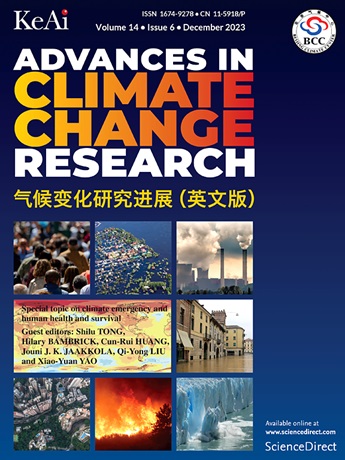利用美国国家航空航天局(NASA)全球每日降尺度数据集 NEX-GDDP-CMIP6 评估青藏高原极端降水量
IF 6.4
1区 地球科学
Q1 ENVIRONMENTAL SCIENCES
引用次数: 0
摘要
本文章由计算机程序翻译,如有差异,请以英文原文为准。
Evaluation of precipitation extremes over the Tibetan plateau using the NASA global daily downscaled datasets NEX-GDDP-CMIP6
The utility of statistically downscaled data is in its provision of detailed, high-resolution insights, surpassing global models, which is essential for precise assessments of climate impact. This study delves into the changes in extreme precipitation across the Tibetan Plateau (TP) and its five subregions, thereby deepening our understanding of climate impacts in the region. Employing NASA Earth Exchange Global Daily Downscaled Climate Projections (NEX-GDDP-CMIP6), which are bias-corrected and statistically downscaled, in conjunction with three gauge-based datasets (CN05.1, CMFD, GMFD) spanning from 1979 to 2014, this study conducts an extensive analysis using eight extreme precipitation indices in the TP. The findings reveal significant spatial disparities in extreme precipitation, with the southern subregion experiencing a significant increase while the two northern subregions show statistically insignificant changes. NEX-GDDP-CMIP6 performs best in the eastern subregion but fails to capture extreme precipitation characteristics in the southern and western subregions. Averaging over the whole period of 1979–2014 (climatology), the NEX-GDDP-CMIP6 dataset performs better on the intensity and persistence indices than on the absolute and relative threshold indices. NEX-GDDP-CMIP6's performance on climate trends is significantly below that of climatology. The NEX-GDDP-CMIP6 dataset has limitations over the TP because of its reliance on the underperforming GMFD reference data. This study provides a comprehensive understanding of the variability of extreme precipitation and disparities among different subregions of the TP, laying a robust scientific groundwork for climate impact studies and future projection in this region.
求助全文
通过发布文献求助,成功后即可免费获取论文全文。
去求助
来源期刊

Advances in Climate Change Research
Earth and Planetary Sciences-Atmospheric Science
CiteScore
9.80
自引率
4.10%
发文量
424
审稿时长
107 days
期刊介绍:
Advances in Climate Change Research publishes scientific research and analyses on climate change and the interactions of climate change with society. This journal encompasses basic science and economic, social, and policy research, including studies on mitigation and adaptation to climate change.
Advances in Climate Change Research attempts to promote research in climate change and provide an impetus for the application of research achievements in numerous aspects, such as socioeconomic sustainable development, responses to the adaptation and mitigation of climate change, diplomatic negotiations of climate and environment policies, and the protection and exploitation of natural resources.
 求助内容:
求助内容: 应助结果提醒方式:
应助结果提醒方式:


